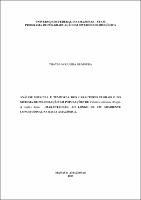| ???jsp.display-item.social.title??? |


|
Please use this identifier to cite or link to this item:
https://tede.ufam.edu.br/handle/tede/5849| ???metadata.dc.type???: | Tese |
| Title: | Análise espacial e temporal dos caracteres florais e do sistema de polinização em populações de Calathea altissima (Poepp. & Endl.) Korn. (Marantaceae) ao longo de um gradiente longitudinal na Bacia Amazônica |
| ???metadata.dc.creator???: | Moura, Thaysa Nogueira de  |
| ???metadata.dc.contributor.advisor1???: | Webber, Antonio Carlos |
| ???metadata.dc.description.resumo???: | As interações planta-polinizador têm sido usadas extensivamente como sistemas modelo para explorar aspectos básicos da evolução. Uma ideia comumente aceita no estudo da polinização é a de que as plantas tendem a se especializar em certas espécies polinizadoras e, possivelmente, a recíproca também ocorra. Dois princípios fundamentais vêm norteando o entendimento acerca da evolução das interações plantapolinizador específicas: conceito das síndromes de polinização, que constituem categorias de traços florais e recursos associados à atração de polinizadores especializados, e o princípio do polinizador mais importante que estabelece que plantas podem ser polinizadas por diferentes espécies polinizadoras, mas que na verdade apenas o agente polinizador mais importante seria responsável por influenciar a evolução dos traços florais. Paralelamente ao crescente interesse científico sobre o nível de especialização/generalização das interações planta-polinizador, está a constatação empírica de que tais interações sofrem considerável efeito de variação espacial e/ou temporal. Os polinizadores de uma dada espécie podem variar entre diferentes populações, criando um regime de pressão seletiva divergente ao longo da área de distribuição da espécie, levando ao surgimento de um mosaico geográfico de coevolução. Com a variação espacial e/ou temporal dos polinizadores, estes podem ser um importante fator no surgimento de variações geográficas nos traços florais por meio de adaptações locais e o estudo destes sistemas pode ajudar no maior entendimento acerca dos mecanismos promotores de especiação e da evolução. De acordo com as bases teóricas apresentadas, o estudo teve como objetivo principal investigar o sistema de polinização de Calathea altissima (Marantaceae) em três regiões ao longo de um gradiente longitudinal na Amazônia Brasileira distantes entre si 500 km. Especificamente, buscamos responder as seguintes questões: (1) existe variação espacial nas características florais de C. altissima entre as regiões estudadas? (2) existe variação espacial e/ou temporal no sistema de polinização da espécie entre populações e/ou regiões do estudo? A análise geográfica do sistema de polinização revelou a ausência de variação espacial dos traços florais e ausência de variação espacial e temporal dos agentes polinizadores, indicando que o nível de especialização de C. altissima com relação às abelhas Euglossini seria um atributo próprio da espécie e não uma característica variável entre populações. |
| Abstract: | Plant-pollinator interactions have been used extensively as model systems to explore basic aspects of evolution. A common idea accepted in the study of pollination is that plants tend to specialize in certain pollinators species, and possibly the contrary also occurs. Two fundamental principles have been guiding the understanding of the evolution of specific plant-pollinator interactions: the pollination syndromes concept, which constitute categories of floral traits and resources associated with the attraction of specialized pollinators, and the most important pollinator principle that establishes that plants can be pollinated by different pollinator species, but that in fact only the most important pollinator agent would be responsible for influencing the evolution of floral traits. Parallel to the growing scientific interest in the level of specialization/generalization of plant-pollinator interactions, there is the empirical observation that such interactions undergo a considerable spatial and/or temporal variation effect. The pollinators of a given species may vary among different populations, creating a regime of divergent selective pressure along the distribution area of the species, leading to the emergence of a geographic mosaic of coevolution. With the spatial and/or temporal variation of pollinators, that can be an important factor in the emergence of geographical variations in floral traits through local adaptations, and the study of these systems may help in a better understanding of the mechanisms promoting speciation and evolution. According to the theoretical basis presented, the main objective of this study was to investigate the pollination system of Calathea altissima (Marantaceae) in three regions along a longitudinal gradient 500 km apart in the Brazilian Amazon. We explored the following questions: (1) Is there a spatial variation in the floral characteristics of C. altissima among the studied regions? (2) Is there a spatial and/or temporal variation in the pollination system of the species among populations and/or regions of the study? The geographic analysis of the pollination system revealed the absence of spatial variation of floral traits and absence of spatial and temporal variation of pollinator agents, indicating that the level of specialization of C. altissima in relation to Euglossini bees would be a characteristic of the species and not a variable characteristic between populations. |
| Keywords: | interações planta-polinizador Variação espacial Variação temporal |
| ???metadata.dc.subject.cnpq???: | CIÊNCIAS BIOLÓGICAS |
| Language: | por |
| ???metadata.dc.publisher.country???: | Brasil |
| Publisher: | Universidade Federal do Amazonas |
| ???metadata.dc.publisher.initials???: | UFAM |
| ???metadata.dc.publisher.department???: | Instituto de Ciências Biológicas |
| ???metadata.dc.publisher.program???: | Programa de Pós-graduação em Diversidade Biológica |
| Citation: | MOURA, Thaysa Nogueira de. Análise espacial e temporal dos caracteres florais e do sistema de polinização em populações de Calathea altissima (Poepp. & Endl.) Korn. (Marantaceae) ao longo de um gradiente longitudinal na Bacia Amazônica. 2017. 44 f. Tese (Doutorado em Diversidade Biológica) - Universidade Federal do Amazonas, Manaus, 2017. |
| ???metadata.dc.rights???: | Acesso Aberto |
| ???metadata.dc.rights.uri???: | http://creativecommons.org/licenses/by-nc-nd/4.0/ |
| URI: | http://tede.ufam.edu.br/handle/tede/5849 |
| Issue Date: | 11-May-2017 |
| Appears in Collections: | Doutorado em Diversidade Biológica |
Files in This Item:
| File | Description | Size | Format | |
|---|---|---|---|---|
| Tese - Thaysa N. Moura.pdf | 639.38 kB | Adobe PDF |  Download/Open Preview |
This item is licensed under a Creative Commons License





